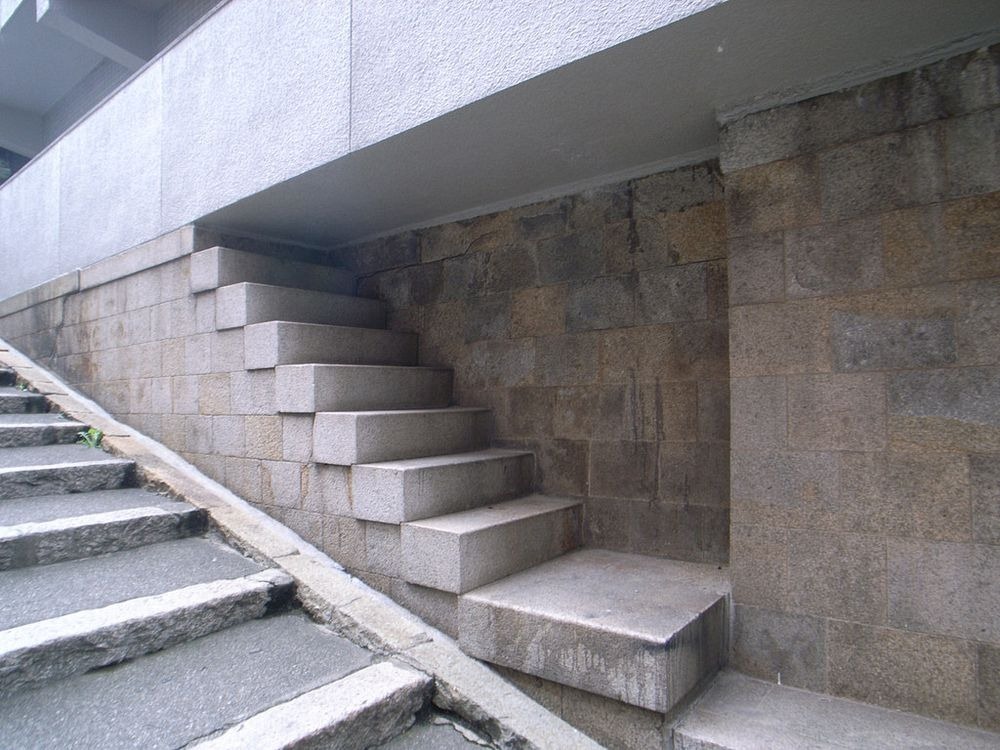A city is like a living organism, constantly growing and evolving with time. Buildings get renovated, new structures are added and old ones removed, and in this process bits and pieces get left behind. We have all seen them: a flight of stairs that ends in a blank wall, a door hovering on the exterior of the second floor with no balcony, a walled over doorway.
These architectural vestiges that serve no purposes have a name. They’re called “Thomassons”, a term coined by Japanese artist Genpei Akasegawa, who first began to notice these urban relics around Tokyo in 1972.
A useless staircase at a house in Japan. Photo credit: yosukesan/Wikimedia
While walking to lunch one day, Akasegawa noticed a staircase that had no entranceway when one reached the top. But what really drew his attention were the signs of repair on the handrail on the staircase, indicating that it was still being maintained despite the apparent uselessness of the staircase itself. Akasegawa began to seek out these odd structures. The following year, Akasegawa discovered a boarded up ticket window at a railway station. The plywood used to board up the window had been cut neatly to fit the curved stone tray of the ticket window, where it had been worn through years of use. One of Akasegawa’s friend found a gateway at a hospital that had been completely filled up with concrete.
Akasegawa and his friends began calling them “hyperart”. By Akasegawa’s description, “they were like pieces of art that has no purpose in society but still preserved with care, to the point where it appears to be on display.” But “hyperart” doesn’t have a creator, and cannot be deliberately created by an artist, but only found and recognized as such by an observer.
Those pieces of hyperart were later given the name "Thomasson." The term comes from Gary Thomasson, an American baseball player who was traded to Tokyo’s Yomiuri Giants. Thomasson was paid an exorbitant amount of money for a two-year contract. But when he failed to perform as his managers had hoped, he was benched for most his contract. For Akasegawa, Thomasson was both “useless” and “maintained.”
At first, Akasegawa began publishing his Thomasson photographs at a weekly magazine column. Eventually, these photographs became a book titled Hyperart: Thomasson.
Examples of Thomasson
A useless door. Photo credit: Kunitaka NIIDATE/Flickr
A Thomasson tunnel. Photo credit: Wikimedia

Photo credit: petite-tomo/Flickr
Photo credit: twinleaves/Flickr
Photo credit: RawheaD Rex/Flickr
Photo credit: flasksrw/Flickr
Photo credit: flasksrw/Flickr
Photo credit: Caroline Park
Photo credit: Winni Wintermeyer
Photo credit: Winni Wintermeyer
Photo credit: Winni Wintermeyer
Photo credit: Mathieu C
Photo credit: Andria Lo
Photo credit: Seng Chen
Photo credit: Seng Chen
Sources: Wikipedia / 99percentinvisible / 6sqft.com



























The railing beneath the stair case in the last image is required by building code in some municipalities. It prevents blind people from smacking their heads on the underside of the stairs.
ReplyDeleteI feel the same way about the teal balcony (portico?) with the wrought-iron balustrade which looks totally decorative because it's too short. Also few people build a pointy thing on which someone would rest their hand - instead it would be for the top of a fence to prevent entry. And there's no evidence in the brickwork of an opening that was walled off.
ReplyDeleteAll of these are essentially items that clearly used to have a fuller function at one point in time, before ongoing renovations, but now sit strangely idle no longer connected to the surrounding pieces. They sit alone like a foot, ear, or hand without the rest of the body. I see these more commonly in older cities where a part of wall may have had good function in 1890, but is a strangely disconnected and solitary item in 2017.
ReplyDeleteI don't understand the painted over door one. Where is the evidence it is not in use? Just because it doesn't have a handle on the outside doesn't mean it doesn't open from the inside, I see doors like this on industrial buildings all the time.
ReplyDelete